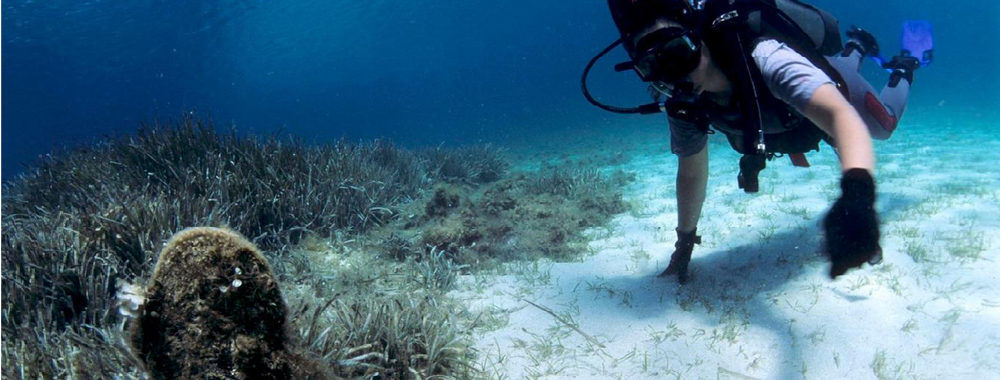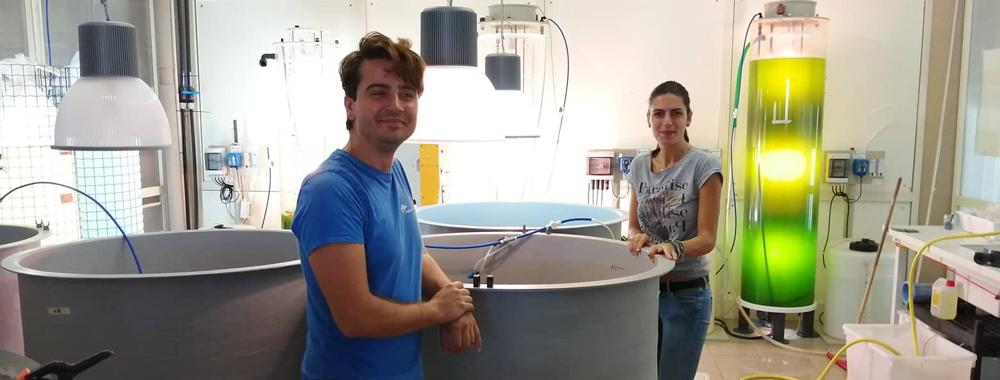The building that hosts the International Marine Center of Torregrande looks at the motionless water bends that find the pond of Cabras among the rushes, at the fish pond of Sa Mardini overlooking its merger at sea, at the great amygdala of the Gulf of Oristano. Geography explains the function. Not only research, monitoring and the preservation of the marine ecosystem, but constant teaching, communication, dialogue and collaboration with the social and economic fabric of the territory. "Transferring knowledge and giving practical application to research has always been one of the primary aims of the foundation, since its origins, thirty years ago" explains in her office Stefania Pinna, researcher and communications manager of the institute.
Dario Vallainc, one of her colleagues, has collected the mullet’s wild breeders in the pond, and now breeds the larvae in large circular tanks, taking care day and night of specimens that must grow healthy, improve their ability to survive. The juveniles grown in the first year of the project have already been placed in the lagoon inside special enclosures, and in few days their release will help to support the natural populations. Next year in Cabras the monitoring system already operating in Tortolì will kick off: a thousand juveniles (at least 6 cm) will be released and marked with a microchip capable of leaving trace of the movements, allowing the constant monitoring of their health. Improving and repopulating the species means preventing local businesses from having to buy the product in in Australia or Mauritania.
Inside the large cylinders of the laboratory algae are bred in stirred water to feed the rotifers, diet of the growing mullets, or the oysters, fed and cured with the intent of allowing local cooperatives, such as that of S. Andrea and S ' Ena Arrubia, to try out its cultivation, potentially of great support to economic sustainability in an era where climate change alters the conditions of the ecosystem, making fishing and profit fragile. "Sea water is penetrating the lagoon system, causing an increase in the degree of water salinity. Some species penetrate the rivers for miles. The balance is significantly altered", says Pinna.
Only partially known are the causes of the death of Pinna Nobilis. An infection that began in Spanish waters exterminated the "castanets", the largest filter feeder in the Mediterranean. The disease is multifactorial. The variations in temperature and salinity, the presence of heavy metals certainly have an impact. The weakened organism is inclined to be attacked by bacteria. In the Marine Protected Area of the Sinis-Isola di Mal di Ventre the presence of the pinna nobilis is reduced to a few specimens. In the past there were thousands. In addition to purifying water, pinna nobilis offers the exterior of their shell to micro-colonizing organisms, while a crustacean species lives inside in symbiosis. From the need to better understand and contextualize the nature of the blight, a "citizen science" project was born. The IMC has created an online platform where anyone who sees a pinna nobilis has the opportunity to report its location. The researchers will then proceed to verify and assess the condition of the organism. A cartography has already been created and allows the analysis and comparison of the relationship between specimens and environment, involving and at the same time enabling awareness in the citizens, some of whom by now don't miss an opportunity to dive and go hunting for castanets in good health. Five specimens were recently found in the pond of Is Benas, one of the most numerous surviving groups.
The Pinna nobilis project is just one of many opportunities to involve the population in the institute's activities. Training courses, lectures with researchers, seminars, collaboration with the universities of Cagliari and Sassari, the aquaculture summer school, the many meetings with schools, the "Zoumate" area on the ground floor, where marine environments have been reproduced and there is often the possibility for children and teen agers of knowing by touch the gulf’s specimens.
"We have the institutional task of transferring knowledge and technologies that increase awareness and make extensive farming sustainable" says the institute's director, economist Paolo Mossone. Success in the relationship with the cooperatives is a patchwork, many subjects take part in the initiatives but only a few go to the end. There is a generational conflict within the cooperatives, although the need to abandon the old production models for more open, fruitful and sustainable solutions is increasingly felt.
"Our relationship with MEDSEA and the Maristanis project is constant, with full synergy and convergence in a vision of sustainability that involves both the environmental, economic and social aspects. Coordinating our actions is essential. This territory needs everything, especially culture. From this point of view, Maristanis is a breath of fresh air. Often we at the IMC find ourselves sowing on freshly plowed land”.

The Island made of mussels in Corru Mannu's pond began to be populated by birds
Little tern, common tern, sandwich tern, rosy gull and black-winged stilt are some of the bird species that have found a home in Corru Mannu in recent weeks. Thanks to…

Sardinian Wetlands, the best way to protect them is "to manage them"
Cagliari, 04.02.2023 – Le zone umide sono ecosistemi acquatici sempre più rilevanti, conoscerli meglio è il primo passo per tutelarli, ma non è tutto. “Serve uno strumento di gestione” per…

The II D from Terralba Institute visited the Old Tower of Marceddì as prize for Terre d'Acqua school contest 2022
Learning about the role of these precious and very important ecosystems, as well as the specificities of the large wetland area of Oristano. In recent days we have accompanied the…

Maristanis was showcased at the Ramsar COP 14 on wetlands during a side event
The 14th meeting of the Ramsar Wetlands Conference (COP14) was held in Geneva from 5 to 13 November 2022, simultaneously also in Wuhan, China. At the International Conference Center in Geneva (CICG) all…

Learning from the Maristanis's model in the ENSERES's visit exchange
Two days to study an integrated management model of marine-coastal systems, two days to strengthen ties and develop new strategies for a sustainable future of the Mediterranean. The Italian stage…

A step forward for the Maristanis project, towards the Regional Park of wetlands in Sardinia
The Municipal Council of Oristano, on the proposal of the Councilor for the Environment Maria Bonaria Zedda, has launched the participatory process and the preparatory actions necessary for the establishment…

Evaluating ecosystem services by the TESSA Methodology in Arborea
How to understand the effects on natural capitals and actual and potential state changes of individual sites important in promoting decisions to support both biodiversity conservation and ecosystem service provision?

Terre D'Acqua 2022, the winners of the school contest within the Maristanis Project
With 87 works, of which 84 in the drawing category and 3 in the comics category, the MEDSEA Foundation's Terre D’Acqua 2022 Competition ends. The school contest took place from February…

The Sardinian farms met in Arborea under the sign of Sustainability
This is the year of relaunch for the La Fiera dell’agricoltura di Arborea (Agricultural Fair of Arborea), one of the most important thematic fairs in Sardinia that promotes the productive, agro and…

Maristanis in the news: Rai and Italia 1 dedicated ample space to the Maristanis Project
The Italian press gave ample space to the Maristanis project in recent months, the Oristanese wetlands and its most important project Maristanis were told in various national and local television reports on…

The winner of the World Wetlands Day in Sardinia 2022 Contest
With a picture taken in the Oristanese lagoons representing a group of flamingos and the sentence "They come / They come back / Sometimes they stop / Like nomads /…

Over 700 visitors for the World Wetlands Day Calendar
Over 700 visitors in the World Wetlands Day collective calendar, put together by the MEDSEA Foundation, as part of the Maristanis project last February, with the aim of promoting the precious…

The World Wetlands Day 2022 in Sardinia lasts a month, the events Calendar
As every year, the World Wetlands Day on the anniversary of the RAMSAR convention (of 1971, Feb. 2nd) calls and Sardinia, in particular the Oristanese area, replies within the Maristanis project that…

World Wetlands Day in Sardinia, from 2 to 27 February join the competition #WWDSardegna on Instagram
In the occasion of the World Wetlands Day which celebrates ponds and lagoons in the world next February 2, the MEDSEA foundation launches the contest on wetlands in Sardinia with the hashtag #WWDSardegna to…

MAVA Steering Committee in Provence: Sardinia was promoted with the Maristanis project
MEDSEA foundation, which has been carrying out the Maristanis project in the Oristano area in Sardinia since 2017, attended last week the yearly meeting of the MAVA steering committee. The session took place from 16 to 17 December 2021 in Châteauneuf-le-Rouge, in the Provence-Alpes-Côte d'Azur region, and gathered together the…

Terre d'Acqua, a wetlands school competition for students in the Oristanese
On February 2, the World Wetlands Day will be celebrated once again the Oristanese wetlands region. To recall the central role of wetlands in addressing climate and environmental crisis and to raise awareness of the importance of these basins especially in this west coast side…
- 1
- 2
- 3
- 4



